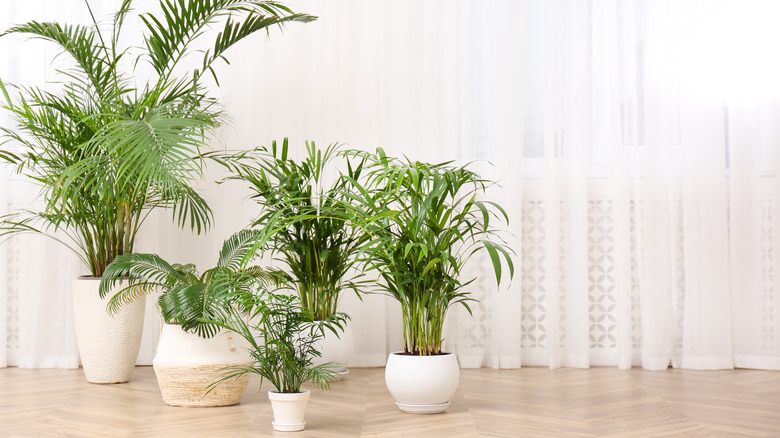Garden
Tiffany Selvey
Potted palm trees add a tropical flair to your home, but these plants do not need tropical conditions to thrive. Although there are over 2,500 varieties of palms worldwide (via Jay Scotts), only a handful grow well as houseplants. Parlor palm (Chamaedorea elegans) trees are among the easiest to find at garden centers and are usually inexpensive. This variety is a favorite among houseplant enthusiasts because it grows quickly, has minimal requirements, and is safe for homes with pets.
Other beloved palm varieties include the majesty palm (Ravenea rivularis), which grows slower than the parlor palm but whose gorgeous fronds are well worth the wait. This cultivar is becoming more common and easier to find at retailers and online. For a more exotic look, the Chinese fan palm (Livistona chinensis) is a gorgeous plant that can grow up to 10 feet tall in a planter under the right conditions. However, regardless of the variety you select, palms have specific requirements for them to thrive indoors.
Ideal growing conditions for potted palms

New Africa/Shutterstock
As tropical plants, all palms have specific humidity, soil, temperature, and sunlight requirements. Dry air is a problem for potted palms and can cause the leaves to start to brown at the tips, states Creative Design Manufacturing. The ideal humidity for palms is around 50%, which can be challenging to maintain in the winter. Using a humidifier near your plants or misting them a few times a week can help prevent the leaves from drying out. The same is true for palms in dry soil. A peat-based soil mix is ideal because it drains well while retaining enough moisture to keep roots healthy.
Palm trees grow well in average home temperatures. Unless you keep your home below 45 degrees Fahrenheit, any palm should be able to thrive since its preferred temperature range is 60 to 80 degrees Fahrenheit. These plants also grow best in bright, indirect sunlight. Since they are understory plants, direct sun will scorch their leaves, but a sunny room on the south side of your house is the perfect place for a palm to thrive. If you do not have an area with a lot of sunlight, parlor palms are a good option in a space with lower lighting conditions.
Potted palm maintenance
Marina Meshcherskaia/Shutterstock
Palms like consistently moist soil, so regular watering is a must to avoid browning leaves. Thus, you should provide water whenever the soil’s surface is dry. Brown leaves are a sign of dry soil, while yellowing leaves may indicate that the roots are staying too wet. Since palms grow primarily in spring and summer, the Clemson Cooperative Extension suggests only fertilizing your plants about every two months between April and August with a slow-release fertilizer explicitly made for palms.
While pruning is different for every plant, palms have some unique requirements. Older fronds will naturally fade away, but as they do, they continue to provide nutrients to the palm plant. Removing these older leaves prematurely can inhibit your plant’s growth. Even though they are not pretty, try to wait until a frond is completely brown before removing it. Also, you should never prune a palm tree down to a certain size. This will create an unsightly and unhealthy plant. Instead, plan ahead and ensure the variety you select is the right size for your space when it reaches maturity.